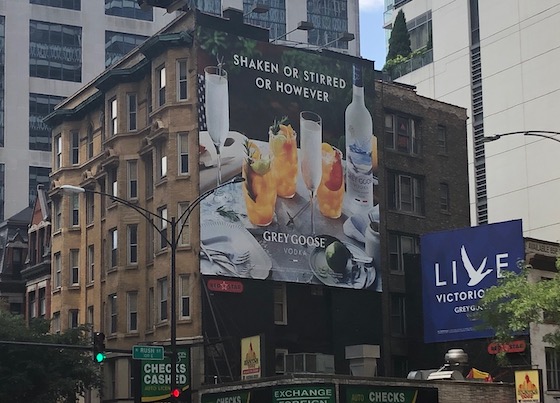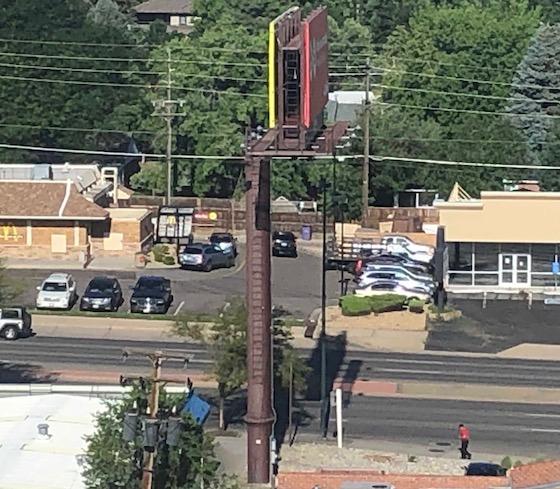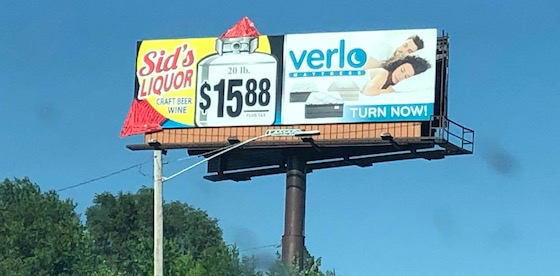Memo From Frank
On September 3, 1783, the Treaty of Paris was signed by John Adams, Ben Franklin and John Jay, which formally ended the American Revolutionary War between Britain and the United States. What’s odd is that most people think that date was July 4, 1776 – which was actually the date that the Declaration of Independence was produced. But the actual success of that dream did not happen until roughly seven years later. In those seven years, there were many battles and hardships, and that’s where true independence from Britain was forged. So we sort of celebrate the dream but not the reality with our national holiday. The moral is that it’s one thing to want to accomplish something, but a whole different thing to actually do it. There’s no purpose in creating a dream unless you take the necessary actions to make it into a reality. Start your reality today.
How Do You Get A Permit For A Wallscape Billboard?

A “wallscape” is defined as a billboard that uses the side of a structure as its sole support. These are among the most lucrative signs in the U.S., as they are extremely large and rent for large amounts yet cost a fraction of the amount to build as a traditional sign of that size. So if we’re all in agreement that they are a great investment, the bigger question is “how do you get one?”
The permitting process
Wallscape ads are often exempt from the Highway Beautification Act because they are located more than 660’ off of the federally funded highway system. This means that you may be able to build a wallscape with only the receipt of a city permit. Make sure that you fully understand how this process works on a state, county and city level. In some cities, you may have to enter into some type of specialty arrangement for these permits that has a certain time limit on them.
Obtaining the lease for the wall space
Most wall owners are more than interested in getting “money for nothing” as the wall is not creating any current income stream. That being said, some are easier to work with than others. So you will want to select locations that have three attributes: 1) legal under the permitting process 2) an amenable property owner who will work with you and 3) good road visibility. Sign these leases up and file for the permits on them.
Installation
Building a wallscape is not difficult. You typically just drill stainless steel “hooks” into the wall of the building that the advertising vinyl then attaches to. But that’s not to say that it’s easy, because you have to typically use a crane with a bucket to reach the wall and the hooks, as there’s no other form of access.
Other considerations
Probably the biggest issue with wallscapes is the difficulty in illuminating them. Lights can't hang in midair. This means that 99% of these are not lighted, and this will impact the type of advertisers that you can put on the ads, such as hotels that prefer night traffic. You also want to be extremely sure that the property owner will not find the advertisement you use offensive, such as an ad for another parking company on the side of their parking garage.
A potential loophole in certain instances
Some wallscapes operate under a special loophole that some cities have, which is a grey area between a “premise” sign and a “non-premise” sign. Using this loophole, a wallscape could potentially advertise Pepsi simply because there’s a vending machine in the building that sells Pepsi. In some cities, they have tried to subdue this loophole by demanding that any advertisement represent a certain percentage of the property’s revenue to be considered “premise”. But you might check this out.
Conclusion
Wallscapes are very lucrative, but they have their own subtle nuances that need to be followed. This list will get you started on the right foot.
All About Building Signs On Property Lines

This is a billboard located on a property line. You see these across America. But why would sign owners want to build on the property line? There are actually quite a few reasons.
The reasons why you would want to do it
There are several important reasons that you would want to locate your sign on a property boundary line:
- It keeps the sign out of the way of future development of the property that might cause the lease to be terminated.
- It keeps the sign out of the way of the property’s operation, so that it does not interfere with things.
- It keeps the sign far away from the tenants own premise sign, so that the two don’t block each other.
- It keeps any bird dropping issues (a big deal on some properties) far away from any cars.
That’s why you see so much of this as these are all very important items.
How the structure does this
A billboard structure is able to sit on the edge of a property line by using a construction technique called an “offset”. In this arrangement, the sign column goes straight up and then at a right angle of sufficient distance to allow all parts of the sign to remain on the correct side of the property. This is somewhat of an engineering marvel, and is not inexpensive, but well worth the additional money.
Stories of mistakes people have made
Although the concept is simple, there are many mistakes that billboard owners have made over time, so here are some examples you need to avoid.
- If the sign is not set to be parallel to the property line, it will overhang the neighbor at one end. If the property line is not at a right angle to the highway, you have to make sure that the sign is at the same angle as that angle.
- Make sure to take into account the additional distance needed from the property line to account for the light fixtures. Otherwise, the lights will hang 4’ into the neighbor’s property and you may not be able to illuminate that side of the sign.
- Make sure you have a plan to access the sign and change the ads without ever having to set foot or overhang the neighbor’s land. They will already be mad at you for building a giant sign on the edge of their land and will not work with you in all likelihood if you need access across their property.
Conclusion
Building signs on property lines is standard industry practice in many markets. It makes sense from a sign owner’s perspective. You should consider doing the same.
The Ultimate Billboard Boot Camp
![]() How to Find a Billboard Location
How to Find a Billboard Location
![]() How to Buy a Billboard
How to Buy a Billboard
![]() How to Build a Billboard
How to Build a Billboard
![]() How to Operate a Billboard
How to Operate a Billboard
![]() How to Rent Ad Space on a Billboard
How to Rent Ad Space on a Billboard
![]() How to Sell a Billboard
How to Sell a Billboard
Get Your Copy Now!
The Many Applications Of "Solaray"

The arrow in the advertisement shown above has a reflective nature and “shimmers” in the daylight. How does it do that? The trick is a product called “solaray” that has been around for decades. It’s basically a form of sequin (like you find on a ball gown) only on a scale appropriate for billboards. Whereas the sequins on a dress are maybe ¼ inch in diameter, the sequins on a billboard are more like 2” in diameter. I have used them many times to maximize the effect of the sign on attracting attention. It’s inexpensive and highly effective.
How Do You Approach Finding Billboard Locations In Any City?

So you are interested in building a portfolio of billboard signs. But how do you get started? What is the standard playbook for getting into the business? Here are the basic steps.
Understand the state, county and city ordinances
Billboards are a federally regulated industry – one of the few left in the U.S. (airlines and trucking companies used to also be on that list). As a result, it is filled with laws and ordinances, and obtaining the permit is the key fixture to getting started. As a result, you have to become an expert in your market on what the laws are. And not just the local ones. You need the state and county, as well, and you may need to apply for an receive a state advertising license (which is not that difficult in most states).
Make a short form analysis of the zonings and spacings required
From those state, county and city ordinances you need to establish a short form of requirements that are basic and easy to use, which is normally what zonings billboards are allowed in, as well as the spacings required between signs. On land outside of a city limits, the zoning is typically a broad range of “unzoned commercial” and you need to know the definition of this classification.
Map out the highways and roads of interest
Billboards rely on certain amounts of traffic and viewers to be worthwhile. And this means that there is no purpose in trying to build billboards on roads that advertisers have no interest in paying money to be seen on. The good news is that you can buy traffic count maps from the state highway department that will tell you specifically how many viewers there are on each major road. Most billboards need roughly a 24-hour traffic count of 5,000 cars per day to be worthwhile.
Sectionalize the city into areas of greater interest and priority
Every city and market has a “hot” area and a “cold” area as far as new development and advertising desirability. The key is to make sure that you spend your time in the right general areas of the market. One suggestion is to get a hold of the state’s logbook of all new road construction for the next decade (most states have these on line or sell them). It shows each road project and is broken up under a timeline of 1) planning and engineering 2) right of way purchase 3) bidding of construction 4) construction with an estimated date of opening. If you map these new projects out, you’ll get a good idea of where the future development is.
Apply your knowledge
There’s an old saying “think like a man of action and act like a man of thought”. There’s no purpose to study the industry unless you take action with that knowledge. It may mean getting out of your comfort zone, but there’s no risk until you actually enter into leases and obtain permits. And, as you offer leases and apply for permits, you’ll learn more granular data on what works and does not work, and you’ll become even better at the process.
Conclusion
Getting into the billboard business requires knowledge and desire. But it’s not an impossible dream. You just have to get down to business and get started.
